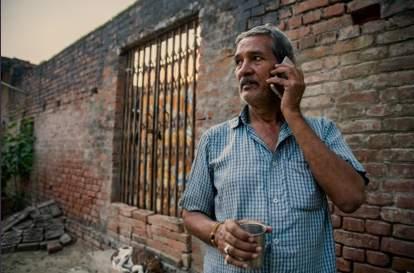
30 minute read
RTM for Development Sujoy Mojumdar Koushiki Banerjee
Monitoring
RTM for Development
Advertisement
Sujoy Mojumdar Koushiki Banerjee
Development programmes are actively embracing real-time monitoring approaches across a range of sectors; from maternal health to nutrition and water, sanitation and hygiene (WASH)-to improve planning, monitoring, and decision making efforts. It has been critical in helping UNICEF and other organisations deliver timely data to government partners and others to help inform key policies and programming decisions.
The Importance of Real-Time Monitoring
The use of real-time monitoring (RTM) to support national systems strengthening is growing, primarily due to the ubiquitous penetration of mobile phones into global audiences. According to the International Telecommunication Union, in 2011 alone, there were six billion mobile subscribers–with 79 per cent of them in the developing world (Abaza and Marschollek, 2017). This has been a boon in countries and regions where mobility and physical connectivity challenges can affect the diffusion of knowledge of key issues, which can stymie progress against key health and socioeconomic indicators. India is no stranger to RTM systems, having been one of the early adopters of mobile and digital technology in the low-and-middle-income world. It has 1.16 billion telecommunication subscribers in the world, as of March 2019 (TRAI, 2019), and has been adding nearly six million subscribers per month (TRAI, 2019). In fact, the Ministry of Health’s National Health Portal has shortlisted a whopping 72 monitoring platforms that have been authorised to track indicators from health records in hospitals to mapping water supply sources (2020).
Development programmes are actively embracing RTM approaches across a range of sectors; from maternal health to nutrition and water, sanitation and hygiene (WASH)- to improve planning, monitoring, and decision making efforts. During this COVID-19 response, it has become an even greater priority to invest in RTM models that adhere to physical distancing protocols. Caseloads are increasing rapidly with shorter doubling times and countries are scrambling every day to better understand what is influencing the outcomes as quickly as possible. Plus, given the transmission model, traditional monitoring efforts such as door-to-door assessments come with
Individuals answering IVR survey on water, sanitation and hygiene service availability in his household and community
Sujoy Mojumdar is UNICEF WASH Specialist. Email: smojumdar@unicef.org Koushiki Banerjee is WASH Monitoring Focal Point. Email: kbanerjee@unicef.org
high risks for health and community workers. Real-time monitoring that allows low-touch data collection and dissemination would therefore be best in this context, as proven before during the Ebola and H1N1 outbreaks, both which had similar contact restrictions.
The practice of real-time monitoring for strengthening national monitoring systems has been employed by UNICEF and government partners to strengthen health, education, water and sanitation and social protection systems around the world. As of 2019, 77 UNICEF country offices including India’s are using real time approaches enabled by the use of information and communication technologies which enable faster retrieval and analysis of data and information, than paperbased or other traditional systems.
When using real-time approaches, data and information is provided more rapidly than before and allows stakeholders to monitor progress towards goals by rapidly accessing and reviewing data and information, seeing trends, and identifying corrective actions required based on informed evidence-based decisions within a day, or in some cases, within a few hours. Therefore, it is an efficient solution to monitoring needs and objectives. Just as important to keep in mind is that RTM approaches are only effective where the capacity to utilise frequent data and insights is sufficient and responsive; otherwise, the approach may have a negative effect of creating extra data collection burden without commensurate response.
When implemented, RTM integration helps to: y
Provide a monitoring platform for communities and governments to track progress towards shared goals
Identify supply, demand and bottlenecks in service delivery chains
Increase accountability of y government to the rapid delivery of services Improve service delivery to hardto-reach communities through informing corrective measures
y
Assess and educate consumers and beneficiaries on relevant knowledge, practices and attitudes.
Scalable Routine Data Collection and Dissemination System
In 2014, UNICEF, in partnership with Nyaruka Ltd, released RapidPro, a globally accessible and free open source routine data systems application (https://rapidpro.io/).
Development programmes are actively embracing RTM approaches across a range of sectors; from maternal health to nutrition and water, sanitation and hygiene (WASH)-to improve planning, monitoring, and decision making efforts. During this COVID-19 response, it has become an even greater priority to invest in RTM models that adhere to physical distancing protocols.
RapidPro “collects data via short message service (SMS) and other communication channels (e.g. voice; social voice; social media channels, such as Facebook Messenger, Telegram, WhatsApp) to enable real-time data collection and masscommunication with target end-users, including beneficiaries and front line workers.”(UNICEF, 2020). Its prior avatar, RapidSMS, was launched in 2008 to send text messages and was mainly used in Africa to monitoring child health and HIV interventions; however, there was a call for more functionality that options not dependent on paid telecommunication lines. In 2015, the RapidPro Surveyor application was created to provide a chat-like interface on smartphones without network connectivity (Dial, 2018).
It has in part been successfully taken up because of its flexibility in information capture and delivery, and because it has been critical in helping UNICEF and other organisations deliver timely data to government partners and others to help inform key policies and programming decisions. RapidPro has been developed to be a ‘global public good’ by UNICEF and the ambition is to garner investment to encourage the buy-in of real-time monitoring systems in 110 countries by 2021.
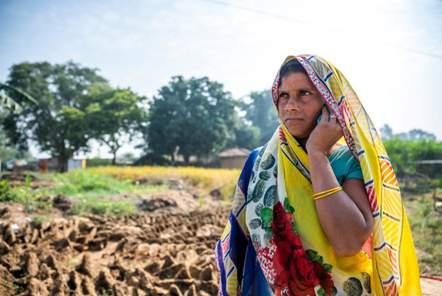
It functions through the integration of the following key elements:
Flows: Flows are the set of interactions based on user responses to questions, which determine what the subsequent action is. By using flow architecture, the creator can establish automated and complex text and voice pathways without programmer assistance.
Channels: These are used to send and receive messages. This includes SMS, voice, and social media, and can be used either to push data as part of education campaigns out or collect it from users for monitoring and assessment purposes. New channels are being added to RapidPro.
Campaigns: Flows, channels and messages come together under a campaign, which is the automated framework for RapidPro-based RTM. This allows both communication with users on a large-scale and personalisation based on user feedback, through flow architecture.
Analytics: Analytics displays the data generated by interactions with end users, by displaying results in real-time within RapidPro or sending them to a customised dashboard for further visualisation, generating a
custom report, or exporting to Excel for additional analysis.
Integration into Various Countries’ Programmes
Albeit being available for less than a decade, RapidPro has already been leveraged for a range of purposes across countries, from soliciting feedback from adolescents on what health issues matter to them to monitoring knowledge and attitudes around water, sanitation and hygiene programmes. Below are a few global examples that illustrate its functionalities:
(i)
Water, Sanitation and Hygiene
Status in Rural India
In 2019, RapidPro was piloted in two of India’s most populous states, Uttar Pradesh and Bihar, which carried almost 30 per cent
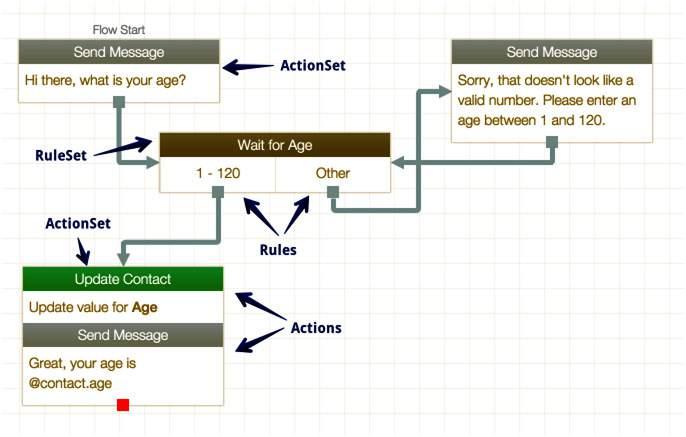
Example of a flow concept that can be coded for on the platform. The channel for this can be anything from SMS to voice to social media. (Source: http://rapidpro.github.io/flows/concepts/) burden of open defecation globally (Coffey et. al. 2014) at the start of Swachh Bharat Mission, to assess the status of sanitation services and related knowledge. UNICEF India used the interactive voice response (IVR)–or, automated calling with pre-recorded messages-as the communication channel. UNICEF’s field offices supported their respective state governments in developing the application according to each state’s needs, and the IVR flows were launched in four districts: Gaya in Bihar; Sonbhadra, Mirzapur and Bhadoi in UP. Various categories of questions on sanitation and hygiene access and usability were asked in multiple-choice format to users identifying as (i) members of rural households, (ii) swachhgrahis (community sanitation workers) and(iii) Gram pradhans(village heads) to ensure reliability and a holistic perception around sanitation services. This allowed the governments to not only appreciate the tool for its flexibility and scaled reached, but also to receive rapid inputs to questions they were interested in. In UP, for example, approximately 3,500 users responded to the calls, and the crowdsourced responses indicated that 92.1 per cent of households have functional toilets and 96 per cent of households with them had all members using the toilets.
(ii)
U-Report: A Global Tool
U-Report is a free messaging tool built using RapidPro in 2011 and is currently used by UNICEF and partners in 60 countries, benefitting 8 million users (UNICEF, 2020 (b)). Its objective is to encourage participation of youth, through popular social media channels, in a safe environment in which they do not feel judged for asking about critical or sensitive issues. Its function, as opposed to the convention RTM objectives, is to provide a conversational option. Its most popular functions are to provide feedback–through polls for participants via social media–by
An example of flow set-up for the Uttar Pradesh WASH RapidPro effort, where each flow targeted a different stakeholder population
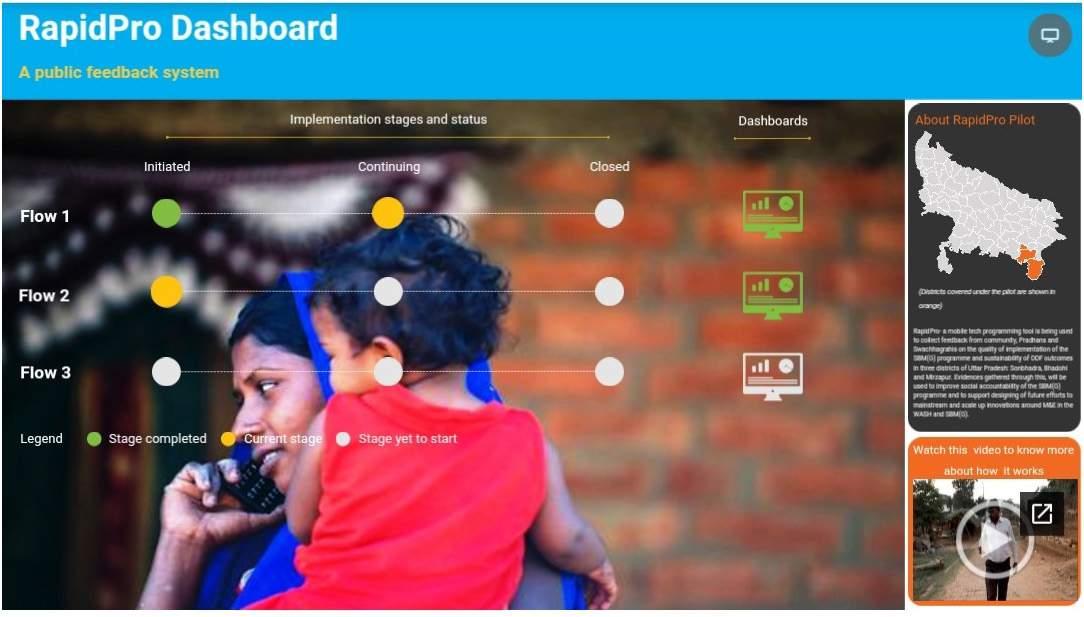
providing knowledge and information on specific issues that participants want to build their capacities on. Its success has broadened its reach to the general populous.
As of 30 March, 2020, U-Report has been used for assessing knowledge, practices and attitudes around COVID-19 across 43 countries, with responses collected from over 2.2 million people. In India, UNICEF recently collected 23,000 responses from 28 states and four union territories, to a U-Report survey assessing the general population’s existing understanding of the COVID -19 pandemic and the sources of information that they rely on. Respondents had the option of completing the survey over WhatsApp or Facebook Messenger, in ten languages. The results showed that, even with the inundation of messages received through WhatsApp, 67 per cent of respondents cited the television as their primary source of information and one-fifth of the users found it difficult to practice social distancing, this especially from rural respondents.
(iii) Real-time Monitoring of Social
Cash Transfer Programme in
Nepal
UNICEF Nepal supports the Government of Nepal in monitoring social cash transfers disbursed in ‘child grant’ expansion districts, through RapidPro. In Nepal, a quarter of the population lives in poverty, meaning that many children are affected by multiple deprivations. The RapidPro pilot started in 2018 and targets
mothers receiving cash transfers from the government with SMS and IVR messages that help improve both governance accountability and knowledge within the beneficiary population. The tool sends out polls through IVR to beneficiaries about grant implementation and delivery, and pushes key information about the child grant programme in general, to ensure that recipients know about registration and payment days. Through the platform over 68,000 children’s caregivers were reached, as per mid-2019, and almost 30 per cent being actively responsive to IVR calls. This monitoring effort showed that 47 per cent of beneficiaries reported spending child grants on education and 36 per cent on nutrition. Some also gave feedback on the challenges in accessing the transfers, which will help the government figure out pointed solutions based on the user’s area of residence.
Lessons Learned
While RapidPro has been received positively in the global community, its
success, again, is very much dependent on how it is utilised by the users i.e. governments, development partners and other stakeholders. The following are key lessons garnered from various countries’ range of interventions, as well as recommendations for going forward: • Flexible real-time monitoring options such as RapidPro are important for development.
Accountability and transparency is hard to maintain and manage at a large scale, when hundreds of thousands to millions of people are involved in progressing towards a national goal. RapidPro offers a structured and low-touch approach that allows for just that, and ensures that the data is being analysed in accordance to the objectives defined without integrity loss due to human error, physical bulk issues such as paper-based collection and review, and disagreement in analysis approaches later on in the process. Especially in countries as large, culturally and geographically diverse as India, digital tools can easily respond to many demands and challenges in social sector programming.
Integration requires time, capacity building and buyin from multiple stakeholders with various perspectives.
Governments and other users should cater for the time required to set up logistical arrangements internally and with data network operators, develop and pilot questions or messages that will be useful and not redundant, create functional dashboards, train implementers on utilising the data and its representations, and so on. This is important for sustained interest in the approach as well as ensuring that the resulting policy or programming action is as accurately reflective of collected data as possible.
It is important to keep equity in mind, especially when seeking to include the most marginalised and vulnerable.
While telecommunications seems to have saturated all markets globally, there are still many populations living at the edges of modern society’s resource spread, who perhaps would not be able to add their voice to monitoring systems that use tools they do not have access to. Implementers should realise that RTM platforms are not the end all of information and require scrutiny at all steps to ensure that the right respondents are being included directly or through complementary efforts.
Another key population to keep in mind is women, who customarily have lesser access to digital communication options, yet are often the most likely to take up social issues and roles as community leaders.
There are many other lessons that can be sourced from the tool’s website. Regardless of which tool itself is used, the overall objective should be
to collect and inform policies based on data that is as representative as the population being served by a government or any implementer. When considerations around equity, feasibility and personalisation needs are taken into account, RapidPro offers itself as a highly viable option for a gamut of programmatic objectives that can inform everything from grassroots action to national guidelines.
All views, thoughts and opinions are personal and do not necessarily reflect on the position of the authors’ organisation.
Article Contributors
1.
2. Nicolas Osbert, Chief of WASH, UNICEF (nosbert@unicef.org) Swathi Manchikanti, WASH Specialist, UNICEF (smanchikanti@unicef.org)
3. Neelam Pol, Innovations Specialist,
UNICEF (npol@unicef.org). Images Credit : UNICEF Uttar Pradesh
References
1.
2.
3. Abaza, H & Marschollek, M (2017). mHealth Application Areas and Technology Combinations. Methods of Information in Medicine; 56 (Suppl 1). URL: https://www.ncbi.nlm.nih.gov/pmc/ articles/PMC6291822/
Coffey, D et al. (2014). SQUAT Survey. Online. URL: http://swachhsangraha.gov. in/sites/default/files/SQUAT-researchpaper.pdf Digital Impact Alliance (dial) (2018). RapidPro Surveyor, UNICEF. Online. URL: http://im.digitalimpactalliance.org/ rapid.html
4. India (2020). Online. URL: http://nhp. gov.in/m-health_mtl Press: Press Release No 87/ 2018. Telecom Regulatory Authority of India, viewed on 14 June 2019, https://main.trai.gov.in/ sites/default/files/PR_No.87of2018.pdf.
5.
6. 2019. Telecom Regulatory Authority of India, New Delhi, https://www. Report_15012020_0.pdf
8. National Health Portal, Government of
TRAI (2018). Information Note to the TRAI (2019). Annual Report 2018–trai.gov.in/sites/default/files/Annual_ 7.
UNICEF (2020, a). Real time information–RapidPro. Online. URL: https://www. unicef.org/innovation/rapidpro UNICEF (2020, b). U-Report. Online: URL: https://www.unicef.org/innovation/ U-Report
SPECIAL ARTICLE
Covid-19 Virology
Dr Sarah Cherian Dr Priya Abraham
This century has witnessed the emergence of three different coronaviruses (CoVs) that have spread beyond the country that they were first identified in. They are- Severe Acute Respiratory Syndrome CoV (SARS-CoV) in 2003, the Middle East Respiratory Syndrome CoV (MERS-CoV) in 2012, and the 2019 novel CoV (2019-nCoV, later officially named SARS-CoV-2). First identified in Wuhan (Hubei, China) in December, 2019, CoV disease 2019 (COVID-19) caused by SARSCoV-2 was declared a pandemic by the World Health Organisation (WHO) in March, 2020.
SARS-CoV-2 and other CoVs belong to subfamily Coronavirinae in the virus family Coronaviridae comprising four genera Alphacoronavirus, Betacoronavirus, Gammacoronavirus and Deltacoronavirus. These are enveloped with positive sense single-stranded ribonucleic acid (RNA). The word “corona” in Latin means “garland, wreath or crown”. Coronaviruses have characteristic club-shaped peplomers projecting out of the virus envelope. CoVs are known to infect different animal species and can cross species’ barriers to cause illness in humans. Alphacoronaviruses and betacoronaviruses are transmissible to humans. The alphacoronavirus strains 229E and NL63, along with the betacoronavirus strains OC43 and HKU1, tend to cause only mild symptoms in humans. The betacoronavirus strains MERS-CoV, SARS-CoV and SARS-CoV-2, all can cause severe respiratory distress with mortality up to the tune of 34.4%, 9.19% and 6.8% respectively, though there may be regional differences (Prompetchara et al., 2020; Tu et al., 2020).
Since its discovery in Wuhan city in Hubei province, in late December 2019, the virus has spread to 215 countries and territories, infecting over 45 lakh individuals and leading to over 3 lakh deaths. Most of the early cases had links to the Wuhan wet/ seafood market, where speculation about the animal source/intermediate host ranged from bats, snakes and pangolins (Huang et al., 2020; Cyranoski 2020). However, to date no confirmed animal host has been identified with certainty. This review summarises the knowledge with respect to the viral agent causative of COVID-19 disease, its transmission and symptoms, epidemiology, and the treatment strategies being pursued.
The SARS-CoV-2 Virus Structure, Etiology, Genome and Replication Cycle
The SARS-CoV-2 virus has a diameter of approximately 50–200 nm and possesses spikes on its surface (up to 20 nm in length) that provide it the crown-like appearance under an electron-microscope (Figure 1). Like other CoVs, the virus is sensitive to ultraviolet rays and heat. Furthermore, these viruses can be effectively inactivated by lipid solvents such as ether, ethanol, chlorine-containing disinfectants, and chloroform (Cascella et al., 2020).
Figure 1: Transmission electron microscopy image of SARS-CoV-2.
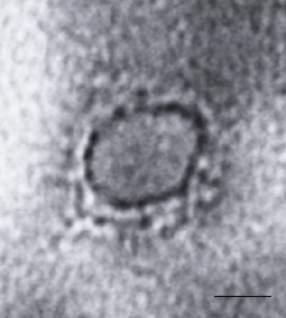
The CoVs are amongst the largest known RNA viruses with genomes
Dr Sarah Cherian is Scientist F at National Institute of Virology, Pune. She heads the Bioinformatics Division of the Institute. Dr Priya Abraham is the Director, National Institute of Virology, Indian Council of Medical Research, Pune. Email: director.niv@icmr.gov.in (Author for correspondence)
Figure 2: A simplistic schematic representation of the replication process in SARS-CoV-2 within a human cell.

approximately 30kb in length. The SARS-CoV-2 genome (29,891 nucleotides) comprises majorly of four structural proteins, i.e., nucleocapsid (N) protein that holds the viral RNA; spike (S) protein; envelope (E) protein and membrane (M) protein that create the viral envelope (Perlman et al., 2009). SARS-CoV-2 enters host cells using the surface S protein to bind to the host receptors of epithelial cells in the respiratory tract. The angiotensinconverting enzyme 2 (ACE-2) has been identified as the predominant receptor for SARS-CoV-2 (Wrapp et al., 2020). This process is dependent on S protein priming by a host serine protease (TMPRSS2) (Matsuyama et al., 2020). Once the virus enters the host cell, the viral RNA is released into the host cell cytoplasm. Viral RNA is translated to produce polyproteins which are further cleaved to form structural proteins for the RNA replicase transcriptase complex, which is responsible for the replication and transcription of viral RNA. Viral nucleocapsids are assembled and bud from the endoplasmic reticulum Golgi intermediate compartment (ERGIC). As viral nucleocapsids encase viral RNA to produce new CoV virions, they are budded out. Figure 2 provides a schematic representation of the replication process.
Genome comparison of SARSCoV-2 showed that it had maximum (96.3%) nucleotide identity with BatCoV RaTG13 sequence, 89% identity with bat SARS-likeCoVZXC21 and 82% identity with that of human SARS-CoV (Chan et al., 2020; Andersen et al., 2020). Based on this, the virus causing COVID-19 was called SARS-CoV-2. Genomic analyses thus suggested that SARS-CoV-2 probably evolved from a strain found in bats. The potential amplifying mammalian host, intermediate between bats and humans, that could have directly triggered virulence towards humans, is yet to be identified. The Malayan pangolin CoV spike protein sequence
The SARS-CoV-2 virus has a diameter of approximately 50–200 nm and possesses spikes on its surface (up to 20 nm in length) that provide it the crown-like appearance under an electronmicroscope. Like other CoVs, the virus is sensitive to ultraviolet rays and heat. Furthermore, these viruses can be effectively inactivated by lipid solvents such as ether, ethanol, chlorine-containing disinfectants, and chloroform.
is more similar to the SARS-CoV-2 in the receptor binding domain of the spike protein(Xiao et al., 2020)
Transmission
Animal-to-human transmission was assumed to be the main mechanism of transmission initially as the first cases of the COVID-19 disease were linked to direct exposure to the Huanan Seafood Wholesale Market of Wuhan. However, noting that subsequent cases were not associated with this exposure mechanism, it was concluded that the virus could also be transmitted from human-to-human. Though symptomatic people are the most frequent source of COVID-19 spread, the possibility of transmission before symptoms develop could not be excluded.
As with other respiratory pathogens, including flu, the transmission occurs primarily through respiratory droplets from coughing and sneezing, but it can also occur through contact with contaminated surfaces. Viable viral particles may remain on stainless steel and plastics and other fomites for up to 72 hours after application (Doremalen et al., 2020). Aerosol transmission is also possible in case ofprotracted exposure to elevated aerosol concentrations in closed spaces. The possibility of faecal–oral transmission of SARSCoV-2 also cannot be ruled out, though more evidence is needed.
Incubation periods for SARSCoV-2 may vary but have been known to be generally within 3 to 7days with the median observed to be 5.1 days (95% confidence interval [CI]: 4.5- 5.8 days), with 97.5% of those who develop symptoms doing so within 11.5 days (95% CI: 8.2-15.6 days) of infection (Lauer et al., 2020).
The basic reproduction number (R0), or the number of cases directly generated by one case in a population where all individuals are susceptible, has been reported to be between 2.13 and 4.82, which is similar to SARS
CoV (Julien et al., 2020). Data showed thatthe doubling time was about every seven days (Tsang et al., 2020).
Epidemiology
As of May 19, 2020, a total of 47,31,458 confirmed cases of COVID-19 occurring in at least 215 countries/territories were reported with 3,16,169 deaths (WHO, 2020). The estimated case-fatality rates ranged from 0.5% to 5.7% (Yang 1 et al., 2020). Children population seems to be the least affected by the disease, while the highest rate of death is among the elderly and people with comorbidities. Few reports have suggested an in vivo evolution of the virus, which may explain the rapid spread and changing epidemiology of SARS-CoV-2(Shen et al., 2020), but further evidence is needed.
A study from China that included more than 70,000 COVID-19 patients revealed that majority of the confirmed cases were aged between 30-79 years (86.6%) (Wu et al., 2020; Chen et al., 2020). Among about 1,000 deaths, the majority were among patients of >60 years of age, with the 80 years age group characterised by the highest fatality rate (~20%). Relatively fewer cases were reported among young children (0-9 years old); while more males were affected by the disease, the male-to-female ratio being ~1.06:1 in China.

Initially, among countries excluding China, the countries with most cases were Italy and the Islamic Republic of Iran. The epidemiological scenario since has drastically changed. According to WHO statistics (as of 19 May, 2020), the most reported cases are in United States of America (14,77,516), Russian Federation (2,99,941), The United Kingdom 2,46,410, Brazil (2,41,080), Spain (2,31,606) and Italy 2,25,886. Today about 34.4% (74/215) of reporting countries are experiencing local transmission of the infection (WHO, 2020).
Clinical Features and Progress of Disease
Symptoms and signs of COVID-19 may appear 2 to 14 days after exposure and can most commonly include fever, dry cough, fatigue, generalised body ache, nausea, vomiting diarrhoea and shortness of breath. Most infected individuals may be asymptomatic while some may present with acute respiratory distress syndrome. Severity of illness is associated with advancing age and those with other medical conditions such as diabetes, hypertension and chronic lung disease.
Once SARS-Cov-2 enters the respiratory tract, it leads to infection of angiotension converting enzyme 2 (ACE2) expressing target cells such as the alveolar type 2 cells and perhaps other unknown target cells in the lungs (Prompetchara et al., 2020). Cells infected with virus may escape the interferon (IFN1) produced by the host which may lead to increased virus replication in the lungs. The gastrointestinal symptoms of COVID-19 may be caused by direct viral damage to the intestine rather than the immune-pathogenic response to the lung infection of the host. There is recruitment of neutrophils, macrophages and monocytes to the release of high levels of proinflammatory cytokines. The “cytokine storm” leads to inflammation related lung injury. Death which is mainly seen in the elderly is finally due to multiple organ failure.
Laboratory Diagnosis
For early diagnosis, detection

of SARS-CoV-2 viral RNA is recommended. There are many assays that detect viral RNA using real-time PCR. Most screening assays detect the envelope (E) gene. If it is positive, confirmatory testing to detect other viral genes such as the RNA dependant RNA polymerase (RdRP) gene, the Orf1 gene and the nucleocapsid (N) region is carried out. Currently, there are many manufacturers of these real time PCR assays. They, however, have to be certified by regulatory agencies receiving the US Food and Drug Administration Emergency Use Authorisation (FDA-EUA) or receive Conformitè Europëenne (CE) marking. Other assays will have to be validated by established governmental laboratories that have been certified for testing. For viral RNA testing, nasal, throat, nasopharyngeal or oropharyngeal swabs are required. The need of the hour is to have sensitive assays that are more affordable with a shorter turnaround time.
Several immunoassays are now available to detect IgM and IgG class of antibodies, the immune response to the virus. They may be rapid lateral flow immunochromatography based, enzyme immunoassay based or automated chemiluminescence immunoassays. Most assays can detect IgM antibodies by approximately

Animal-to-human transmission was assumed to be the main mechanism of transmission initially as the first cases of the COVID-19 disease were linked to direct exposure to the Huanan Seafood Wholesale Market of Wuhan. However, noting that subsequent cases were not associated with this exposure mechanism, it was concluded that the virus could also be transmitted from human-to-human.
the 10 th day and IgG antibodies by the 20 th day post infection (Vashist, 2020). Their use is mainly for serosurveillance and sero-epidemiology and cannot substitute viral RNA detection in acute cases.
Treatment Strategies
Under the circumstances of no specific treatment for COVID-19 currently, supportive care and prevention of complications is of utmost importance in clinical management. Ventilator support is given for patients experiencing respiratory distress. Conservative fluid management is given as it may worsen the lung oedema, interfering with oxygen delivery. Systemic corticosteroid therapy is not recommended either, as it may delay viral clearance.
Currently, there is not sufficient evidence that any existing antiviral drug can efficiently treat COVID-19 pneumonia. However, there are several clinical trials on potential antiviral therapies taking place. The drug therapies can be divided into two main categories depending on their target. The first acts on the coronavirus directly, either by inhibiting crucial viral enzymes responsible for genome replication, or by blocking viral entry to the host cells. The second class of inhibitors act on the host immune system or inhibit inflammatory processes. Most of these drugs are actually being repurposed for the COVID-19 trials (Tu et al., 2020). Among the ongoing drug therapy options for COVID-19 are repurposed drugs like remdesivir, favipiravir, that exhibit broad-spectrum antiviral activity as virus replication inhibitors, HIV protease inhibitors such as lopinavir and ritonavir, virus-cell membrane fusion inhibitors such as recombinant human Angiotensin-Converting Enzyme 2 (rhACE2), entry inhibitors like Arbidol (umifenovir), antiparasitic agents such as ivermectin and anti-malarial drugs such as
hydroxychloroquine. Interferons are secreted by the virus-infected cells and recombinant interferon therapy either used alone or in combination with other drugs, is being tried as immune system enhancers. Intravenous immunoglobulin, neutralising antibodies, monoclonal antibodies, thalidomide, methylprednisolone etc. are being evaluated for attenuating the inflammatory response. Plasma therapy and convalescent sera therapy are also being implemented to treat SARS-CoV-2 patients and has shown some encouraging results. Herbal therapies are also an attractive therapy option for the COVID-19 disease as clinical evidence has shown the beneficial effect of traditional Chinese medicine (TCM) in the treatment of SARS-CoV-2 (Yang 2 et al., 2020).
Several trials are also initiated to test vaccines targeting the SARSCoV-2 (Tu et al., 2020). Multiple nucleic acid-based vaccine candidates have been proposed. Among the vaccines under trial include a lipid nanoparticle-encapsulated mRNA vaccine that does not require the virus, DNA vaccine candidates, a vaccine composed of a nonreplicating adenovirus vector and the genetic sequence of the S protein of SARS-CoV-2, a stabilised subunit vaccine, a nanoparticle-based vaccine using antigens derived from the CoV S protein and a genetically modified
Among the vaccines under trial include a lipid nanoparticle-encapsulated mRNA vaccine that does not require the virus, DNA vaccine candidates, a vaccine composed of a non-replicating adenovirus vector and the genetic sequence of the S protein of SARS-CoV-2, a stabilised subunit vaccine, a nanoparticle-based vaccine using antigens derived from the CoV S protein and a genetically modified artificial antigen-presenting cells (aAPCs) expressing the conserved domains of the viral structural proteins delivered by lentivirus vector.
artificial antigen-presenting cells (aAPCs) expressing the conserved domains of the viral structural proteins delivered by lentivirus vector. However, the development of these vaccines currently represents a more long-term strategy to prevent COVID-19 outbreaks in the future.
Concluding Remarks
It must be emphasised that further studies are needed to understand the mechanisms of transmission, the incubation time, the clinical course, and the duration of infectivity of the SARS-CoV-2. Several public measures are being taken at local, national and international levels to reduce the rates of transmission, including social distancing and self-isolation. Unfortunately, as no effective treatment or therapeutic drug is available for the disease, only supportive treatment and classical intervention measures are available currently for confronting the SARSCoV-2 pandemic.
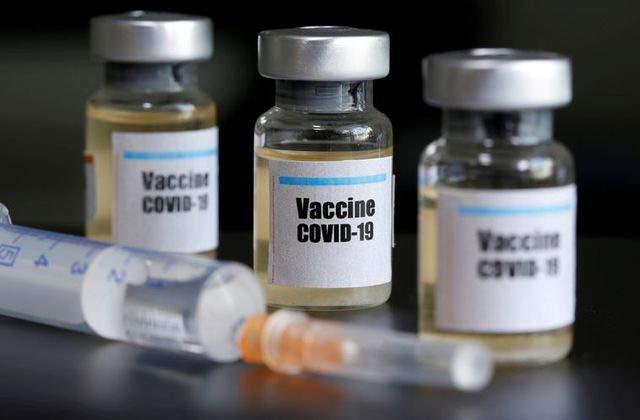
The SARS-Cov-2 pandemic has no doubt posed a significant challenge globally on the public health system. It is also a lesson in that more systematic approaches are needed to prepare ourselves in advance for any potential future pandemics. Finally, an understanding of the spill over from bats to humans possibly as a result of shifts in their ecology and behaviour, with evidence suggesting that altered roosting habitats, diet, and movement behaviours are increasing. We need to review the ways that changing resource landscapes (urban and agricultural habitats) affect the processes that culminate in crossspecies transmission of viruses. Towards this end, the role played by deforestation, increased contact with wild life, food habits, population density, climate change and increased globalisation in the emergence of such a pandemic needs to be recognised. Enhanced surveillance and ensuring better public health among populations would also be a step in the right direction.
Acknowledgement
We acknowledge technical assistance in the form of the schematic representation by Ms. Bhagyashri Kasabe, Senior Research Fellow, in the Indian Council of Medical Research (ICMR)-funded project (Grant No. VIR/32/2019/ECD1), Bioinformatics Group, ICMRNational Institute of Virology, Pune.
The authors acknowledge inputs from Dr. GSG Ayyangar, Senior Deputy Director General (Admin.), ICMR, Department of Health Research, Ministry of Health & Family Welfare, New Delhi.
Image Courtesy:
Fig.1:Dr Atanu Basu, Senior Scientist & Deputy
Director, ICMR-National Institute of
Virology, Pune.
References
Andersen K, Rambaut A, Lipkin I, Holmes EC, Garry R. The proximal origin of SARS-CoV-2.: Nature Medicine. 2020; 26: 450–452.
Cyranoski D. Did pangolins spread the China coronavirus to people [Internet]. Heidelberg: Springer Nature; 2020 [cited 2020 Feb 16]. Available from: https://www. nature.com/articles/d41586-020-00364-2
Chan JF, Kok KH , Zhu Z, Chu H, To KK, Yuan S, et al. Genomic characterisation of the 2019 novel human-pathogenic coronavirus isolated from a patient with atypical pneumonia after visiting Wuhan.: Emerg Microbes Infect. 2020;9(1):221- 236. Cascella M, Rajnik M, Cuomo A, Dulebohn S C, Di Napoli R D . Features, Evaluation and Treatment Coronavirus (COVID-19). Treasure Island (FL): Stat Pearls. 2020 Jan.
Chen, N.; Zhou, M.; Dong, X.; Qu, J.; Gong, F.; Han, Y.; Qiu, Y.;Wang, J.; Liu, Y.;Wei, Y.; et al. Epidemiological and clinical characteristics of 99 cases of 2019 novel coronavirus pneumonia in Wuhan, China: A descriptive study. Lancet 2020, 395, 507–513.
Doremalen NV, Bushmaker T, Morris DH, Holbrook MG, Gamble A3, Williamson

7.
8.
9.
10.
11.
12.
13. BN ,et al. Aerosol and Surface Stability of SARS-CoV-2 as Compared with SARSCoV-1 . (2020). The new england journal of medicine : n engl j med 382;16 nejm. org April 16, 2020. https://www.nejm.org/ doi/10.1056/NEJMc2004973. Huang C, Wang Y, Li X, Ren L, Zhao J, Hu Y, et al. Clinical features of patients infected with 2019 novel coronavirus in Wuhan, China. Lancet. 2020;395:497–506.
Julien R, Althaus C: Pattern of early human-to-human transmission of Wuhan. Euro Surveill. 2020, 25:2000058. 10.1101/2020.01.23.917351. doi:10.2807/1560-7917.ES.2020.25.4. 2000058.
Lauer S, Grantz K, Bi Q, et al.: The incubation period of coronavirus disease 2019 (COVID-19) from publicly reported confirmed cases: estimation and application [Online ahead of print]. Ann Intern Med. 2020.DOI: 10.7326/M20- 0504.
Matsuyama S, Nagata N, Shirato K, Kawase M, Takeda M, Taguchi F: Efficient activation of the severe acute respiratory syndrome coronavirus spike protein by the transmembrane protease TMPRSS2. J Virol. 2020, 84:12658- 12664. Prompetchara E, Ketloy C, Palaga T. Immune responses in COVID 17 and potential vaccines. Lessons learnt from SARS and MERS epidemics. Asian Pac J Allergy Immunol DOI 10.12932/AP200220-0772.
Prompetchara E, Ketloy C, Palaga T. Immune responses in COVID-19 and potential vaccines:Lessons learned from SARS and MERS epidemic. Asian Pac J Allergy Immunol DOI 10.12932/AP200220-0772.
Perlman S, Netland J. Coronaviruses post-SARS: update on replication and 14.
15.
16.
17.
18.
19.
20.
21.
22.
23. Shen Z, Xiao Y, Kang L, Ma W, Shi L, Zhang L, et al. Genomic diversity of SARS-CoV-2 in coronavirus disease 2019 patients. Clinical Infectious Diseases, ciaa203, https://doi.org/10.1093/cid/ ciaa203. Tsang TK, Wu P, Lin Y, Lau EHY, Leung GM, Cowling BJ. Effect of changing case definitions for COVID-19 on the epidemic curve and transmission parameters in mainland China: a modelling study. Lancet Public Health 2020. https://doi.org/10.1016/ S2468- 2667(20)30089-X.
Tu Y-F, Chien C-S, Yarmishyn AA, Lin Y-Y, Luo Y-H, Lin Y-T.; et al. A Review of SARS-CoV-2 and the Ongoing Clinical Trials. A review of SARS-CoV-2 and ongoing clinical trials. Vashist SK. In-vitro diagnostic assays for COVID-19. Recent advances and emerging trends. Diagnostics 2020, 10(4), 202; https:// doi.org/10.3390/diagnostics10040202
World Health Organisation 2 . Coronavirus disease (COVID-19) situation summary. WHO; 2020. Available from: https:// www.who.int/emergencies/diseases/ novel-coronavirus-2019/situation-reports, accessed on May 20, 2020. Wrapp D, Wang N, Corbett KS, Goldsmith JA, Hsieh C-L, Abiona O, Graham BS, McLellan JS. Cryo-EM structure of the 2019-nCoV Spike in the prefusion conformation. Science 2020, eabb2507.
Wu Z, McGoogan JM. Characteristics of and important lessons from the coronavirus disease 2019 (COVID-19) outbreak in China: Summary of a report of 72 314 cases from the Chinese Center for Disease Control and Prevention. JAMA. 2020;323(13):1239-1242. doi:10.1001/ jama.2020.2648. Xiao K , Zhai J , Feng Y, Zhou N, Zhang X, Zou J J, et al. Isolation and Characterisation of 2019-nCoV-like Coronavirus from Malayan Pangolins. bioRxiv preprint doi .https://doi. org/10.1101/2020.02.17.951335 ,this version posted February 20, 2020.
Yang S, Cao P, Du P, Wu Z, Zhuang Z, Yang L, et al. Early estimation of the case fatality rate of COVID-19 in mainland China: a data-driven analysis. Ann Transl Med 2020;8:128. Yang Y, Islam Md S, Wang J, Li Y and Chen X. Traditional Chinese Medicine in the Treatment of Patients Infected with 2019-New Coronavirus (SARS-CoV-2): A Review and Perspective. Int. J. Biol. Sci. 2020, Vol. 16; 1708-1716.










